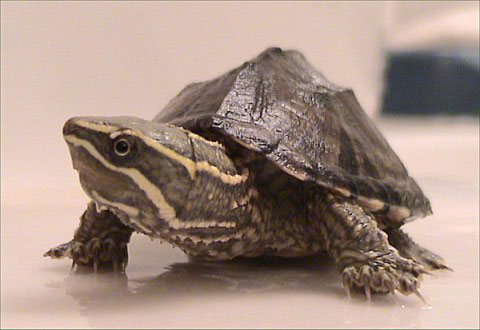Discovered turtle breathed by tongue
Scientists at the University of Vienna, Austria have discovered a special ability of the North American musk turtle, the ability to breathe through the tongue, allowing them to live monthly in the water.
Researcher Egon Heiss and colleagues from the Department of Theoretical Biology used a high-speed camera to record the feeding process of the musk turtle. This is a reptile that lives mainly in the area from the eastern United States and southern Canada, in freshwater lakes and rivers.
Thereby, they discovered, most adult turtles spend most of their time in underwater life, only a few young turtles occasionally go to the mainland to get food.
They observed that the turtles could nibble on food on land with their jaws, but the tongue proved very awkward when mixing food. They even drop the food they make despite trying hard. The only way they can eat is to drop it into the water.

The musk turtle can breathe through the tongue thanks to the respiratory spikes.
This raises concerns for scientists. They studied the structure of the tortoise's tongue using electromagnetic microscopy and optical microscopy to find out why.
What surprised them was that the tongue was weak and poorly developed, but covered with dense thorns. By many tests, researchers found that turtle blades play an important role in gas exchange. When it is under water, the tongue will take oxygen from the water.
Currently, most species of freshwater turtles have to rise to the surface to breathe, while some species breathe in water through the skin or through chambers in the body margin called blood bags.
Until now, musk turtles still hurt scientists because they can stay in water for a long time, even though the skin is too thick to breathe and do not have blood bags. They don't have to constantly climb up to the surface to breathe.
Mr. Heiss: "We know for sure, they must have an underwater respiratory organ. In the end, we found out what to know by chance."
Some other soft-shell species also have respiratory spines on their tongue, but live in areas other than Europe.
The similar blade structure of musk turtle and soft shell turtle suggests a common ancestor of these two groups. Thus, they inherited the advantage of living in a water environment.
Source: Physorg
- Japan discovered 70 million-year-old fossil turtle
- Archaeologists discovered the ancestral skeleton of a turtle
- Discover the world's longest-lived turtle
- The color of the tongue warns the disease
- Warning signs of tongue cancer
- Flower of 3 blades and special ability that only 1% of people in the world have
- The unbelievable thing about the cat's tongue made many people terrified
- Do not confuse tongue cancer and mouth heat
- Stages of tongue cancer and treatment
- Video: The man paints with ... tongue
- 13 facts about turtles that few people know about
- Tongue animals reflect ultraviolet rays threatening enemies
 Animal 'suffering' after hibernation
Animal 'suffering' after hibernation Why do goats climb well?
Why do goats climb well? Scientists were surprised to see chimpanzees eating turtles
Scientists were surprised to see chimpanzees eating turtles Giant catfish died deadly due to drought in Thailand
Giant catfish died deadly due to drought in Thailand